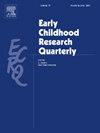教师手势是意义的桥梁:解读教师在故事书朗读中的手势,为词汇提供支持
IF 3.2
1区 教育学
Q1 EDUCATION & EDUCATIONAL RESEARCH
引用次数: 0
摘要
在幼儿阅读书籍的过程中,教师做手势是促进词汇学习的有效策略。虽然研究发现教师在使用手势时存在很大差异,但现有研究并未探讨教师内部和不同图书之间的手势差异,这降低了更好地理解教师和图书如何通过手势来支持语言学习的能力。为了弥补这一不足,本研究调查了九位教师在 108 次观察中对 12 本相同书籍所做的手势,以了解解释教师做手势频率的因素以及教师做手势的方式。我们采用混合方法,估计了多层次模型和描述性统计,以研究图书和教师特征是否能解释教师做出表征性和标志性手势的频率,并采用多模态内容分析和基础理论方法,以更好地理解某些图书如何以及为什么会引起教师做出更多手势。研究结果表明,教师内部的手势频率因图书而异,教师的专业知识与表象手势频率之间存在正相关,教师通过手势来创造情感、概念和动画桥梁,将文字和插图连接起来,以帮助学生理解绘本中的语言。结果表明,文本内容也解释了教师的手势,因此,手势不只是教师的特质,也反映了文本的特质。手势研究和实践应继续将文本选择作为推广这一教学策略的关键。本文章由计算机程序翻译,如有差异,请以英文原文为准。
Teacher gestures bridge meaning: Unpacking teacher gesture in storybook read alouds to support vocabulary
Teacher gesturing is an effective strategy for promoting vocabulary learning during book reading in early childhood settings. While studies find significant variation in teachers’ use of gesture, existing studies have not explored within-teacher and across-book differences in gesturing, reducing the ability to better understand how teachers and books drive gesturing to support language learning. To address this gap, this study investigated the gestures of nine teachers across 108 observations of the same 12 books to understand factors that explain teachers’ frequency of gesturing and the ways in which teachers gesture. Using mixed methods, we estimated multilevel models and descriptive statisics to examine whether books and teacher characteristics explained teachers’ frequency of engaging in representational and iconic gestures and employed multimodal content analysis and a grounded theory approach to better understand how and why certain books elicit more of these gestures across teachers. Study findings show greater within teacher variability in frequency of gesturing as a function of book, a positive association between teacher expertise and frequency of representational gesturing, and that teachers gestured to create emotive, conceptual, and animation bridges to connect the text and illustration to support student understanding of the language in picture books. Results showed that the content of the text also explained teacher gesturing, and thus that gesturing is not solely a teacher trait, but also reflects qualities of the text. Gesture research and practice should continue to consider text selection as critical to promoting this pedagogical strategy.
求助全文
通过发布文献求助,成功后即可免费获取论文全文。
去求助
来源期刊

Early Childhood Research Quarterly
Multiple-
CiteScore
7.00
自引率
8.10%
发文量
109
期刊介绍:
For over twenty years, Early Childhood Research Quarterly (ECRQ) has influenced the field of early childhood education and development through the publication of empirical research that meets the highest standards of scholarly and practical significance. ECRQ publishes predominantly empirical research (quantitative or qualitative methods) on issues of interest to early childhood development, theory, and educational practice (Birth through 8 years of age). The journal also occasionally publishes practitioner and/or policy perspectives, book reviews, and significant reviews of research. As an applied journal, we are interested in work that has social, policy, and educational relevance and implications and work that strengthens links between research and practice.
 求助内容:
求助内容: 应助结果提醒方式:
应助结果提醒方式:


